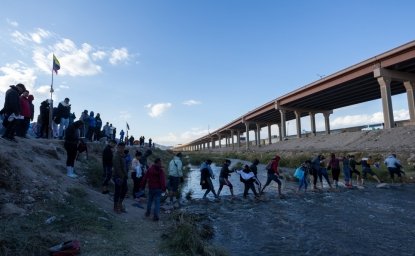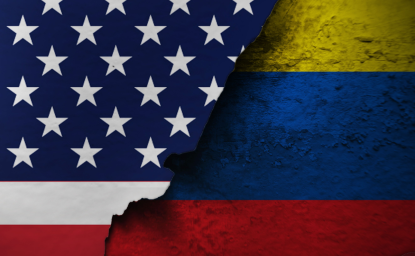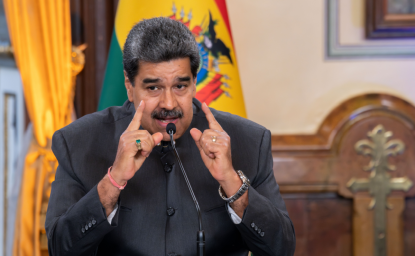Kennan Cable No.17: Russia’s other Pipeline: Migration and Radicalization in the North Caucasus


MOSCOW, RUSSIA: Russian Interior Ministry members stand guard as Muslims attend an Eid al-Adha mass prayer in Moscow October 4, 2014. (Reuters)
Today there are more than 2,000 fighters from Russia on the battlefields of Syria and Iraq fighting on behalf of the Islamic State.[i] A large number of these fighters are Muslims originating from the Northern Caucasus, a fact that feeds a narrative back in Russia that has been growing since the 1990s. Many Russians now link the Muslim populations of the North Caucasus with extremism and terrorism. That perception is not entirely without basis: the North Caucasus region has been rent by war, terror, and brutal state crackdowns for over two decades. But the story of the territory is as much about rapid social change as it is about conflict. Russian state policies over the past two decades have done much to build today’s pipeline of radicalized extremists originating from the North Caucasus to spread across Russia and beyond to the battle zones of the Middle East.
When the Soviet Union collapsed 25 years ago, the population of almost the entire Islamic south of the post-Soviet space still lived in traditional rural communities. Chechnya, Dagestan, Ingushetia, and other territories of the North Caucasus were among the last regions of Russia to urbanize. The urbanization processes that often take generations were compressed here into two short and violent decades.
This disruption has forced thousands of young men and women from rural mountain villages straight into a twenty-first century that conflicted with their traditional way of life in which little had changed since the Middle Ages. Driven by need from the mountain villages of the Caucasus, many left for the big urban and industrial centers of Russia and elsewhere to become truckers, peddlers, marketers, builders, oilfield workers, gangsters, entrepreneurs, dentists, preachers, and devout jihadists. They formed largely unseen transnational networks of migrants who had abandoned their ancient homelands and ways of life, joining the modern age–and in some cases international centers or movements of jihad–in one fell swoop.
The events that drove–and continue to drive–these movements are poorly understood. Yet understand them we must if we are to comprehend the larger developments in that part of the world–including the growing number of fighters from this region prepared to strike within Russia and outside its borders.
I have spent seven years in the field, living among these populations–both those that left and those that stayed–while researching transformation and migration in the highly complex and ethnically diverse North Caucasus, as well as in some large Russian cities, the north of West Siberia (the principal oil-producing area of the country), and Turkey. This article is a summary of some of my findings.
Dislocation, Migration, and Religion
The first driver for migration from the North Caucasus was economic in nature. Migrants left their rural communities to work in Khanty-Mansiysk and Yamal-Nenets Autonomous Districts, two oil-producing Russian districts in the north of Tyumen Region. They also went to large cities where they could earn a living and where, until recently, they did not face any particular persecution for their religious beliefs. Almost 200,000 Dagestanis, Chechens, and Ingush live and work in the oil-producing parts of West Siberia, where half of Russia’s hydrocarbons are extracted. Migrants from post-Soviet Central Asia–Uzbeks, Tajiks, and Kyrgyz–are likewise numerous there. In all, up to one million Chechens and Ingush, one million Dagestanis, half a million Kabardinians, Circassians, Karachays, and Balkarians (an estimated 2.5 million in all) have moved from their homelands to seek work.
Economics was not the only driver of population movements. Interethnic conflict in 1992 in North Ossetia forced thousands of Ingush people out of their homes. The 1994 and 1999 wars in Chechnya displaced hundreds of thousands more people. Once you factor in similar rural to urban migration from the Volga Region, Transcaucasia, and Central Asia, which are still part of a common economic space with Russia, it all adds up to millions of “new urbanites” who have left the rural areas of the former Soviet Union to cities big and small, primarily to Russia.
These dislocated populations, severed from their homes and traditions, would often turn to their religion of Islam as a way to connect with their past, rebuild their identity, and forge community. This growing Islamic renaissance gathered strength, both in the villages and among the communities that scattered in search of work.
Law enforcement agencies in regions with Islamic populations (whether in Russia proper or in the newly independent post-Soviet states) began to persecute Salafites, or Muslims with fundamentalist religious beliefs. These were sometimes referred to as the “new Muslims,” who did not follow the so-called “official clergy” or the old “Soviet imams” that had been loyal to Moscow and were traditionally heavily penetrated by state security services. The new Salafi imams constituted serious competition to the latter.
More importantly, the central government, as well as regional authorities, viewed this growing community of believers as a threat to state power. Some of the new Islamic leaders had received religious training abroad. Some Islamic centers in Russia were funded from abroad. The authorities feared that adherence to what they considered radical Islam would result in allegiance to separatist causes or radical terror movements. That fear only grew with the experience of the two Chechen Wars and other conflicts across the Caucasus.
The State Attacks the Islamic Renaissance on Two Fronts
When the state, both central and regional, began to confront the threat they perceived from Islam to state power, they used two main tools. First, they relied on the use, and abuse, of law enforcement and security agencies to kill, arrest, and intimidate local leaders and believers alike. Second, they instituted laws and propaganda to label certain branches of Islam, and their believers, as extremist. The combination of the two strategies had the desired effect of reducing or eliminating the power and influence of some leaders, but it had some unintended consequences as well.
For example, since 2003 social activists who speak out against corruption and land rights abuses and advocate the right to practice Islam according to one’s beliefs have frequently found themselves on lists of “untrustworthy” citizens. Some have found themselves on criminal “wanted” lists and under investigation for alleged violations of the same criminal code articles as radical Islamist fighters. Being on one of these lists means detentions, interrogations involving torture, and abductions by law enforcement officers, including abductions for ransom.
A typical tactic of law-enforcement agencies in Russia and Central Asia is to plant drugs and ammunition while searching the homes and cars of “new Muslims.” Victims are then arrested and given the choice between a long prison sentence or buying their freedom[ii]…and with it, the chance to leave the country.
Often, if a known Islamic activist is out of the country, law enforcement will orchestrate a surprise search at this person’s home where a hand grenade or ammunition is planted. The message is simple: “Do not come back or we will put you behind bars.” As a consequence of the crackdown on devout Islamic communities, Russia is creating new flows of political and religious emigrants, if not refugees.
The state’s second front directed at devout Muslims is in the realm of rhetoric and law. The Russian state has increasingly identified domestic opponents, especially Islamic activists or clergy, as agents of international terrorism or of foreign secret services. This tactic emerged, particularly against Islamic dissidents, in the days leading up to the Second Chechen War in 1999. Recent laws on extremism make it very easy for the authorities to brand any belief, individual, writing, or group as extremist.
The labeling of persons and organizations as terrorist or extremist has in some cases reached absurd proportions. One lawsuit suggested recognizing a suburban summer home (dacha) association in Dagestan as an extremist organization because someone in authority wanted to take over the property.
In recent years, the Kremlin has taken its terrorism rhetoric against Islamic opponents even further. They cite the many natives of the North Caucasus on the battlefield fighting for ISIS. They point to the military leaders of the Caucasus Emirate (a militant jihadist organization whose stated goal is to establish an independent emirate in the region based on Islamic religious principles) who have sworn public oaths of loyalty to Abu Bakr al-Baghdadi, the head of ISIS. These developments make it easy for Kremlin propagandists to construct a believable narrative of war with the heroic Russian armed forces and special services in a battle against the forces of radical Islam.
Yet Russian special services and the army do not restrict the rhetoric of terror to foreign fighters abroad or genuine extremists at home. They employ the same rhetoric against Islamic activists or groups that the state deems as constituting a threat to its political or economic interests.
Russian Muslims, economic migrants and traditional communities alike, have witnessed the Russian state response towards their Islamic awakening evolve into what amounts to a political terror campaign. The Russian state’s (and society’s) own fears of and responses to an awakening of Islam, one of the four traditional religions in the Russian empire, has created the very radicals they feared. It created an armed underground at home and a pipeline of mujahideen (religious fighters) to Turkey, Syria, and lands controlled by ISIS. In turn, ISIS has built and now maintains a recruiting network in the Caucasus and Central Asia.
Unwinding the Myths of Islamic Extremism in Russia
The Russian state employs three myths to suggest that it is fighting international terrorism when in reality it is engaging in something entirely different.
Myth 1: Russian security agencies in the North Caucasus exclusively combat terrorists.
Moscow has aimed its domestic antiterrorist efforts at a very diverse group of Russian citizens in the North Caucasus. The list of purported extremists and terrorists includes the Chechen nationalists of the First Chechen War (1994–1996), the jihadists of the Second Chechen War (1999–2009), and now claims to combat radical Islamic terrorists across the entire region.
As described above, the indiscriminate tactics of the Russian army and security forces led many Muslims and public activists in these regions to fear persecution and torture at the hands of either the army or law enforcement agencies. They went underground, and many perished in the course of counterterrorist operations carried out by local law enforcement officers, internal troops, and special ops units, many of which used army-style armored vehicles and large-caliber arms.
The Russian state’s war on the region’s Islamic awakening demonstrates that the issue is mainly about maintaining political control. One need not be a confirmed jihadist to be targeted by the state: it is often sufficient to go to the “wrong mosques” or to fail to demonstrate sufficient loyalty to the “official” muftiates of the North Caucasian republics. Failure to adhere to the state’s approved version of Islam and Islamic leaders can and does lead to the charge of extremism, providing justification for law enforcement and security agencies to respond accordingly.
Myth 2: Fundamentalist Islamists from abroad are the principle factor behind the radicalization of Muslims in the North Caucasus and elsewhere in Russia.
One of the most common justifications the Russian state and local authorities use in cracking down on non-traditional Islam is to claim that foreign forces are introducing radical strains of Islam into Russia.
It is true that foreign Islamic nations, including Saudi Arabia, supported students from the region to study Islam abroad and have sent teachers to the region. The rebirth of Islam that accompanied the new freedoms and economic travails of the 1990s spurred growing rivalries with state-approved Imams.
Over time, as political power within Russia re-centralized, authorities from Moscow on down to the regions adopted the tactic of pushing opponents out of the game rather than competing with them. This could be done in a variety of ways. For example, an individual actor with obvious leadership potential could be arrested and see his organization criminalized. This is what happened with Mikhail Khodorkovsky. With social, ethnic, and religious groups, however, the easier option was to accuse them of extremism. Moscow proved ever ready to overlook constitutional violations in exchange for a regional authority’s demonstrated loyalty. The most vivid example is the adoption of a law in Dagestan of September 22, 1999, “On the Prohibition of Wahhabi and Other Extremist Activities in the Territory of Dagestan,” which opened the way to the persecution of groups of citizens on ideological and religious grounds. Legal experts assert that the law is contrary to the Russian constitution. Nonetheless, it effectively gave free rein to local and federal military and security services to conduct politically motivated investigations and effectively instituted a regime of political terror.
By the early 2000s, the post-Soviet elites in the North Caucasus eliminated much of their competition for authority through charges of extremism and terrorism against their political and religious rivals. As a result, a power triangle formed consisting of (1) regional authorities, (2) the administration of the Russian president, and (3) the FSB (inheritor to KGB) and other special services. Under this system, insiders get access to money, power, immunity from prosecution, and patronage power. Everyone else faces political and economic discrimination. Those who resist, politically or in the mosque, are forced out “into the forest” – a euphemism for joining the armed underground that exists in forested areas near villages in the North Caucasus and in safe houses in the cities.
Abuse of security powers has proven most profitable to those connected to the state: one hour of counterterrorism operations can cost around USD $1 million.[iii] Arrests and detentions not only deter undesirable politics or religion, they are also a profit center as relatives are sometimes forced to pay ransoms to get the bodies of their loved ones who were killed during counterterrorism operations for proper burial.
When those who are radicalized do go “into the forest” to take up arms and employ the tactics of terror, such as suicide bombings or hostage crises at schools, theaters, or hospitals, then the broader society grows only more suspicious of individuals from the region and the Islamic faith. In this way, the state secures popular legitimacy for cracking down on the very radicals they helped to create.
Myth 3. All Muslims who have left Russia and other post-Soviet countries are extremists and terrorists who support ISIS ideology and are ready to fight for it.
Russian official sources promote this myth, and many Muslims are surprised to find their names on the lists of wanted Islamic State fighters while spending a vacation in Turkey or studying at Al-Azhar University in Egypt.
Over the past 25 years, many Muslims left Russia to study in Turkey, Syria, the United Arab Emirates, and Egypt. Some chose to stay in those Muslim countries, others would like to return home, but fear persecution. Some Islamic activists are warned not to come back and are threatened with arrest. The last two or three years have seen a sharp rise in the number of Islamic activists leaving for Turkey, Egypt, and Ukraine. This comes as a result of increased pressure from law enforcement agencies—not only in Russia, but also in other post-Soviet countries with large Muslim populations. A large number of such political emigrants (from several hundred to several thousand) find themselves in Turkey. Many, if not most, of these are people who have always been opposed to violence.
Another group of Muslims, numbering several hundreds of people, left to fight in Syria for the opposition forces, such as Jabhat al-Nusra and other Islamic fronts. They are members of the North Caucasus armed underground, affiliated with Caucasus Emirate declared by Dokka Umarov in 2007 as a regional branch of al-Qaeda. Most of them withdrew from fighting in 2014, when ISIS declared the establishment of a caliphate and demanded an oath from all the combatants, but some stayed to fight on the side of Jabhat al-Nusra. They actively assist widows of fighters who try to find their way out of areas that are under ISIS control or when they need financial aid after successfully leaving those areas.
There are more individual stories. Some Muslim fighters who went to fight in Syria failed to reach ISIS and decided to move to a different state in the region. Some grew disillusioned with ISIS and managed to flee to Turkey, Egypt or other countries. These disillusioned fighters, though not numerous, could prove to be very efficient sources of counter-propaganda against ISIS.
And finally, there are 2,000 Russians who left with the sole intention of fighting for ISIS. More often than not, they represent the second generation. Some of their parents were the ones to leave impoverished villages in the North Caucasus or Central Asia to find work in large Russian cities and the north of West Siberia. Some of their parents had the means to send them to study at universities in Moscow, St. Petersburg, and Makhachkala (in Dagestan), among others. This second generation of Muslims from the North Caucasus and beyond, having for years borne the brunt of Russian state pressure and myths, is proving a rich source for ISIS’s recruiters and message.
ISIS recruits from Russia often have nothing to do with Al-Qaeda’s Caucasus Emirate project. And it is not uncommon for them to be Slavs who have converted to Islam.
Conclusion
Further research is needed to understand exactly how Russian state policy and security actions helped create the very Islamic radicals that they feared. But such a study would be incomplete without an examination of the larger social contributions to the issue, particularly the economic dislocation and forced migration of vast numbers of people away from their home villages.
What we can understand now is that Russian state propaganda paints a picture of a foreign invasion of radical Islam that has brought terror to Russia and is now drawing the most dangerous radicals to fight abroad. Yet in truth, radical Islam in Russia, to the extent it exists, is the result of years of repressive Russian policies at the local and federal levels that at first pushed desperate people “into the woods” and are now pushing diverse people (veteran radicalized Russian Muslims, second-generation urban Muslims and newly converted ethnic Russians) through a pipeline of Russia’s own construction onto the battlefields of the Middle East.
The opinions expressed in this article are those solely of the author.
Endnotes:
[i] A. Kirk, “Iraq and Syria: How many foreign fighters are fighting for Isil?” 2016. Available at: http://www.telegraph.co.uk/news/2016/03/29/iraq-and-syria-how-many-foreign-fighters-are-fighting-for-isil/.
Although ISIS fighters come from a variety of countries, it is reported that Russian is the second most common language spoken by all foreign ISIS fighters. Available at: http://temporalflight.tumblr.com/post/110887599637/what-languages-do-isis-fighters-speak
[ii] The results of a survey carried out by the author indicate that the price can range from $20,000 to $30,000.
[iii] The results of a survey carried out by the author indicate that the cost of an operation can be estimated at 60,000 rubles per security operative. A large-scale operation may involve as many as 1,000 security operatives.
Author

Senior Research Fellow, Russian Presidential Academy of National Economy and Public Administration (RANEPA); Research Director, Center for Social and Economic Research of Regions (RAMCOM)

Kennan Institute
After more than 50 years as a vital part of the Wilson Center legacy, the Kennan Institute has become an independent think tank. You can find the current website for the Kennan Institute at kennaninstitute.org. Please look for future announcements about partnership activities between the Wilson Center and the Kennan Institute at Wilson Center Press Room. The Kennan Institute is the premier US center for advanced research on Eurasia and the oldest and largest regional program at the Woodrow Wilson International Center for Scholars. The Kennan Institute is committed to improving American understanding of Russia, Ukraine, Central Asia, the South Caucasus, and the surrounding region through research and exchange. Read more

Explore More
Browse Insights & Analysis
Kennan Cable


